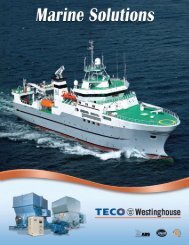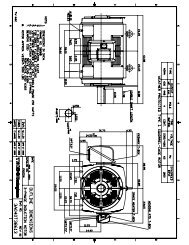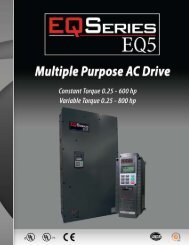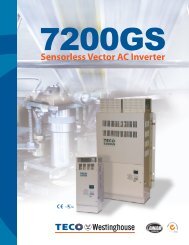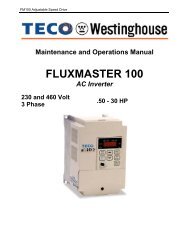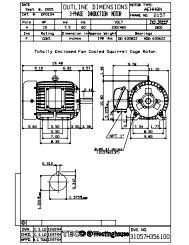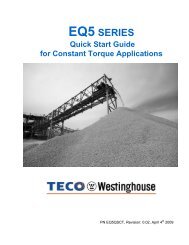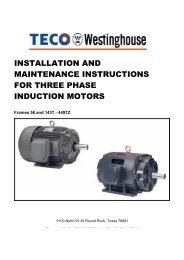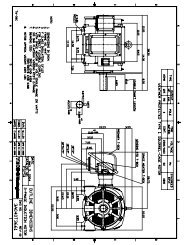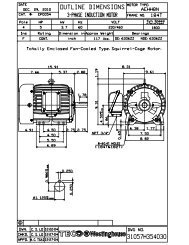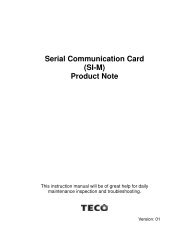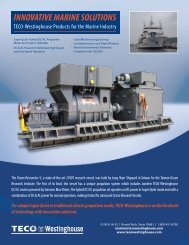EQ7 Series Instruction Manual - TECO-Westinghouse Motor Company
EQ7 Series Instruction Manual - TECO-Westinghouse Motor Company
EQ7 Series Instruction Manual - TECO-Westinghouse Motor Company
Create successful ePaper yourself
Turn your PDF publications into a flip-book with our unique Google optimized e-Paper software.
F10 to F12 Electronic Thermal Overload Protection for <strong>Motor</strong> 1<br />
(Select motor characteristics, Overload detection level, and Thermal time constant)<br />
F10 through F12 specify the thermal characteristics of the motor for its electronic thermal overload protection that<br />
are used to detect overload conditions of the motor.<br />
Upon detection of overload conditions of the motor, the inverter ceases outputting and issues a motor overload<br />
alarm to protect motor 1.<br />
• Thermal characteristics of the motor specified by F10 and F12 are also used for the overload early<br />
warning. Even if only using the overload early warning, set these characteristics data to these function<br />
codes. (Refer to the description of E34.)<br />
• For motors with PTC thermistor, connecting the PTC thermistor to the terminal [V2] enables the motor<br />
overheat protective function. For details, refer to the description of H26.<br />
• Select motor characteristics (F10)<br />
F10 selects the cooling mechanism of the motor--shaft-driven or separately powered cooling fan.<br />
Data for F10<br />
1<br />
2<br />
Function<br />
For a general-purpose motor with shaft-driven cooling fan<br />
(The cooling effect will decrease in low frequency operation.)<br />
For an inverter-driven motor, non-ventilated motor, or motor with separately powered cooling<br />
fan<br />
(The cooling effect is constant regardless of the output frequency.)<br />
The figure below shows operating characteristics of the electronic thermal overload protection when F10 = 1. The<br />
characteristic factors 1 through 3 as well as their corresponding switching frequencies f2 and f3 vary with the<br />
characteristics of the motor. The tables below list the factors of the motor selected by P99 (<strong>Motor</strong> 1 Selection).<br />
Cooling Characteristics of <strong>Motor</strong> with Shaft-driven Cooling Fan<br />
Nominal applied<br />
motor<br />
HP<br />
Nominal Applied <strong>Motor</strong> and Characteristic Factors when P99 (<strong>Motor</strong> 1 selection) = 0 or 4<br />
Thermal time<br />
constant <br />
(Factory default)<br />
Reference current<br />
for setting the<br />
thermal time<br />
constant (Imax)<br />
Output frequency for motor<br />
characteristic factor<br />
Characteristic<br />
factor (%)<br />
f2 f3 1 2 3<br />
0.5, 1<br />
75 85 100<br />
7 Hz<br />
2 to 5 85 85 100<br />
7.5 to 15 5 min<br />
5 Hz 6 Hz 90 95 100<br />
20 Allowable continuous<br />
7 Hz 85 85 100<br />
current<br />
25, 30<br />
150%<br />
5 Hz 92 100 100<br />
40 to 60<br />
Base Base 54 85 95<br />
75 to 125 10 min<br />
frequency frequency 51 95 95<br />
150 or above 33% 83% 53 85 90<br />
4-41



